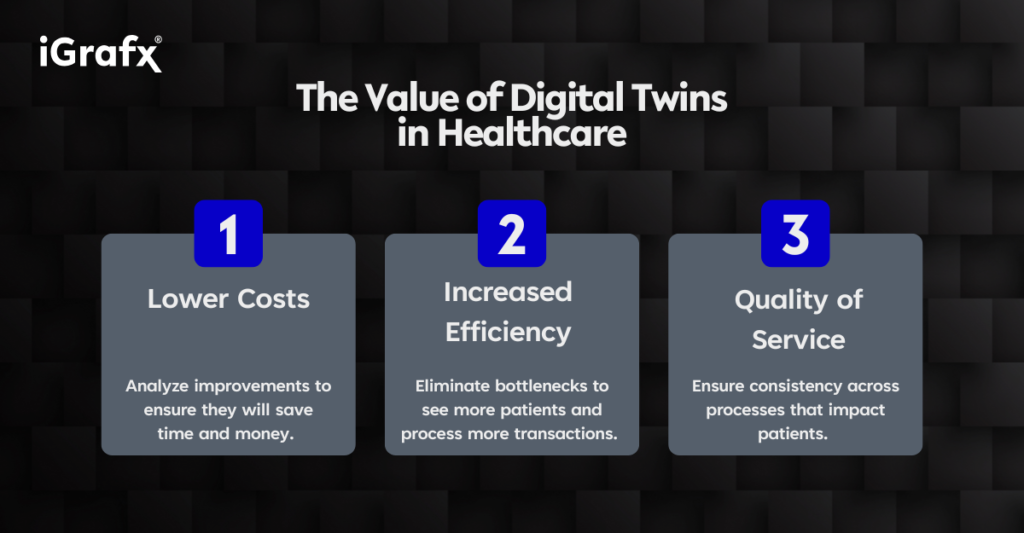In an industry where razor-thin margins, stringent regulations, and skyrocketing patient expectations collide, healthcare leaders need every advantage they can get.
Enter the process-level digital twin: a live, data-driven model of your organization’s workflows that spots hidden bottlenecks, waste, and compliance gaps before they cost you millions.
In this article, we’ll show you how iGrafx’s Process360 Live platform is transforming patient admissions, billing, medication administration, and more—helping providers cut costs, boost throughput, and elevate care quality without risking real-world disruption.
How Process-Level Digital Twins Work
Digital twin technology mirrors how work flows step by step, system by system, person by person, then shows where delays, waste, or risk hide.
This living model is powered by real data from within the systems your company is already using as well as from the expertise of your Subject Matter Experts (SMEs), capturing every process, role, and control that keeps operations running.
iGrafx’s Process360 Live platform is a notable digital twin technology. It allows healthcare providers to tap into real-life process execution data, model its end-to-end processes, and runs “what-if” simulations and predictive analytics so teams can make data-driven decisions that improve operations and fix issues such as bottlenecks without costly trial-and-error.
Why Digital Twins Matter for Operational Excellence in Healthcare
Healthcare processes, from checking in a patient to processing an insurance claim, often involve many steps, hand-offs, and complex rules. Inefficiencies in these processes can lead to longer wait times, higher costs, frustrated staff, and even compromised patient care.
A digital twin offers a data-driven way to visualize and improve these processes.
By creating a dynamic model of an operational workflow, teams can simulate changes, identify bottlenecks, and forecast outcomes before implementing changes in the real world. This capability is invaluable in the healthcare sector, where testing changes in live environments can be risky or disruptive.
Digital twin technology matters in healthcare because it directly addresses key operational excellence goals:
Lower Costs
Operational waste, such as redundant steps, delays, or misallocated resources, can drive up healthcare costs. Healthcare providers often lack visibility into operations, hindering decision-making. With a comprehensive view of processes, organizations can analyze real-time data and simulate future changes to understand the precise impact a change will have – ensuring improvements save time and money.
Process Mining analyzes detailed system data, which can include cost information that may be analyzed at the person or role level, or overall, for the work being performed. You may identify areas where training or other actions can reduce costs. Process Simulation allows you to understand resource and other costs, to see the impact of proposed changes on cost (and other) factors.
Increased Throughput and Efficiency
By Mining, or Simulating, processes and experimenting virtually, healthcare providers can find ways to see more patients or process more transactions with the same resources. From identifying bottlenecks or process non-conformance, to optimizing patient flow to efficient staff allocation and the streamlining of administrative processes, a digital twin can ensure processes are being executed at peak performance.
Consistency and Quality of Service
Variability in how processes are executed can lead to errors or uneven outcomes. Digital twins in healthcare contribute to standardizing operations by modeling best-practice workflows. Once a highly efficient and effective process is modeled, it can serve as a template across departments or facilities, ensuring each patient or claim is handled with the same level of excellence.
In short, digital twins turn the art of process improvement into a science. They provide a single, data-rich view of complex healthcare operations from end to end, allowing organizations to balance efficiency with safety and compliance.
In the following sections, we explore how digital twins are currently being applied in healthcare delivery and the benefits being realized.
How Digital Twins Deliver Operational Excellence in Healthcare
Streamlining Patient Flow: From Admissions to Discharge
One of the most impactful applications of digital twins in healthcare is improving patient flow; the journey of a patient through the healthcare facility, from the moment they arrive (admission) to the point of discharge.
This involves admissions processing, transfers between units, and discharge procedures. Inefficiencies anywhere along this chain can cause long wait times, overcrowding, and poor patient experiences.
Admissions
Consider admissions. This involves collecting personal information, assigning rooms, and initial assessments. Bottlenecks here set the tone for the entire experience.
Depending on system data available, the process can be Mined to validate the actual process occurring, and analyze the process performance based on real data. Regardless, a virtual model of the admissions process helps pinpoint exactly where delays occur. Hospital administrators can then ask powerful “what if?” questions.
- “What if we add one more registration clerk during peak hours? Will wait times drop significantly?” Or,
- “What if we introduce a self-service kiosk for form input?”
By experimenting within the digital twin (the simulation model), they can find the optimal staffing levels and workflow design. A simulation model can even be used for future predictions. For example, what if our patient load increases 10% next year, or an event causes a sudden spike in admissions? How will the process perform, and what can we do to remain responsive, safe, and compliant?
A concrete example comes from one of our clients. Their team used iGrafx process modeling and simulation tools (part of the iGrafx Process360 Live platform) to analyze an admission-related workflow in the women’s clinic. The simulation of the Intermediate Care Center (ICC) for Women showed major wait time contributors and tested potential fixes.
Among the recommendations from the digital twin analysis were: adding a triage nurse at the very start to rapidly assess patients, adding an extra provider (doctor or nurse practitioner) to handle the patient load, and extending the availability of a financial counselor to speed up the discharge paperwork for patients.
All these changes were first vetted in the model to see their effect on patient wait times. After implementing these changes, they reduced the rate of patients leaving before treatment by 50% and generated approximately $1 million in new revenue through improved operational efficiency.
Patient Throughput and Discharge
A patient’s journey doesn’t end at admission. How they progress through treatment units and how efficiently they are discharged also determine operational performance. Digital twins are used to examine these later stages of the patient flow as well.
For example, a hospital might create a digital twin of its bed management and discharge process to answer questions like:
If we introduce a dedicated discharge coordinator role, will it reduce bed wait times for new admissions?
What if pharmacy processing of discharge medications is sped up by 20% – does that meaningfully cut the patient’s length of stay?
By simulating the discharge planning process, hospitals can find the best ways to avoid needless extensions of stay (which not only frustrate patients but tie up resources).
The same project identified discharge as another pain point. Many patients were waiting for financial counseling at the end of their stay. The digital twin suggested extending the financial counselor’s hours would fix this bottleneck.
They implemented this change since hiring additional staff wasn’t in the budget and successfully cleared the discharge backlog, contributing to the overall reduction in patient cycle time.
Improving Billing and Claims Processing Efficiency
This is another process-heavy domain ripe for optimization with digital twins. These processes often involve multiple steps: coding procedures, submitting claims to payers, responding to queries or denials, issuing patient bills, and so on.
Delays or errors in this area can have significant financial impacts (lost revenue, compliance penalties) and affect patient satisfaction (confusing bills or long waits for insurance resolution).
Digital twins allow organizations to visualize the entire flow of financial information. By mapping the claims lifecycle from generation to payment, process owners can see exactly how long each step takes and where backlogs form.
This virtual representation can integrate real data such as average coding times, insurer response times, and typical rejection rates to create a realistic simulation.
One practical use is to experiment with process changes or resource allocations. For instance, if claims approvals are lagging because a small team is manually reviewing each claim for compliance, a hospital might simulate what happens if they introduce an automated claim-checking software or reassign some staff to this task.
This kind of actionable insight helps in justifying investments like automation or additional training by providing evidence of improvement in throughput (e.g., more claims processed per day) or reduction in errors (e.g., fewer claims denied due to coding mistakes).
Enhancing Medication Administration and Clinical Processes
Medication administration involves prescribing, dispensing, and delivering the correct medications to patients at the right times, a process that cuts across healthcare professionals, doctors, pharmacists, and nursing workflows. Errors or delays here can directly impact patient safety and outcomes.
Standardizing Medication Workflows
In many hospitals, the process of administering drugs includes verifying orders, dispensing from pharmacy, transporting meds to the ward, and nurses confirming patient identity and dosage before giving the medication.
There are many potential points of failure (e.g., a transcription error in the order, a delay waiting for pharmacy approval, a missed dose due to scheduling).
By examining medication rounds, a healthcare provider might realize that a particular ward has frequent delays because nurses wait on the pharmacy for medications that require special preparation.
Recognizing this, management could test a potential change: For example, adjusting pharmacy staffing or introducing an automated dispensing cabinet in that ward. The simulation would show if this change reduces the turnaround time from prescription to administration significantly.
Reducing Errors and Variability
Digital twins also highlight where variations occur in a process that ideally should be uniform. If one shift of nurses follows a different medication verification procedure than another, that inconsistency could lead to errors.
The twin model, especially when linked with real time data (like incident reports or timing data), can identify such patterns. The organization can then implement training or process changes to standardize the procedure.
Beyond medication administration, digital twins can be applied to other clinical operations such as surgical scheduling, diagnostic testing workflows, and emergency department triage.
Anywhere there is a complex process, Mining that process for real-life (and real-time) data, or using a simulation model can help provide the visibility needed to make meaningful improvements, and justify the business case for making those improvements.
Compliance Layer: Risks You See, Fines You Don’t
Hospitals and other healthcare organizations face numerous regulations: privacy laws like HIPAA (which governs patient data confidentiality), healthcare laws like the Affordable Care Act (ACA), specialized regulations such as COBRA and MHPAEA for insurers, and accreditation standards that demand certain protocols.
Additionally, organizations have internal risk controls to prevent errors, fraud, or unsafe practices. So, how do digital twins help with all this?
Embedding Regulatory Requirements
A digital twin model of a healthcare process can be built with compliance checkpoints baked in.
For example, consider a process for handling patient medical records. HIPAA requires that access to patient records is limited to those with a need to know. In a process twin, one can model user roles and permissions at each step.
By doing so, the twin can be used to identify any points in the process where sensitive patient health data might be over-exposed or where a hand-off could lead to a privacy breach.
Risk Controls, Predictive Analytics and Proactive Management
Beyond formal regulations, healthcare operations have internal risk controls, for example, requiring dual sign-off on an expensive purchase. By modeling these controls in the digital twin, organizations can verify that risk mitigations are effective and universally applied.
Digital twins also greatly simplify audit and documentation tasks. Since the twin serves as a living model of how processes work (including all the compliance checkpoints and responsible parties), it becomes a single source of truth that can be shown to internal or external auditors.
Instead of pulling scattered policy documents, a compliance officer can demonstrate using the process documentation that shows “here are all our control points and here’s who is accountable at each step.”
This central documentation can streamline external audits because everything is mapped, and any changes to the process are logged and auditable.
To illustrate, imagine a hospital compliance team using a digital twin to ensure adherence to medication handling regulations (let’s say a rule that all controlled substances must be accounted for at each hand-off).
The twin shows the journey of a controlled drug order:
- doctor prescribes
- pharmacy dispenses (with logging)
- nurse receives and administers
- remaining drug is returned or wasted according to protocol each with a sign-off.
The team can analyze and identify if hand-offs lack the proper documentation or if any step tends to happen when a supervising pharmacist isn’t available (which might be a compliance gap).
From there, the team can identify steps in the process that eliminate the issues and simulate how those changes will impact the process and implement them.
Conclusion: The Path to Operational Excellence
So, as we’ve seen, digital twin technology represents a truly transformative approach for healthcare organizations striving for operational excellence.
By focusing on these practical, everyday processes – admissions, patient flow, billing, medication administration – and by deeply integrating risk and compliance considerations, healthcare providers and payers can use digital twins not just to optimize performance, but to uphold and even elevate the high standards of service and compliance that the healthcare industry, and patients, demand.
The key to unlocking this potential lies in applying this technology thoughtfully, in a way that is inclusive of the very people who make healthcare work – the dedicated staff. It’s about having clear goals, using the right tools, and encouraging a culture that is open to data-driven change.
When these elements come together, digital twins can help healthcare organizations achieve what once seemed like competing goals: faster processes, lower costs, safer operations, and ultimately, what matters most, better patient outcomes. These are the true markers of operational excellence.


